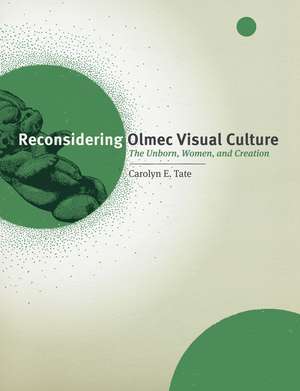Reconsidering Olmec Visual Culture: The Unborn, Women, and Creation
Autor Carolyn E. Tateen Limba Engleză Hardback – 2012
Reconsidering Olmec Visual Culture is the first study that situates the unique hollow babies of Formative Mesoamerica within the context of prominent females and the prevalent imagery of gestation and birth. It is also the first major art historical study of La Venta and the first to identify Mesoamerica's earliest creation narrative. It provides a more nuanced understanding of how later societies, including Teotihuacan and West Mexico, as well as the Maya, either rejected certain Formative Period visual forms, rituals, social roles, and concepts or adopted and transformed them into the enduring themes of Mesoamerican symbol systems.
Preț: 448.59 lei
Preț vechi: 582.59 lei
-23% Nou
Puncte Express: 673
Preț estimativ în valută:
85.85€ • 89.39$ • 72.55£
85.85€ • 89.39$ • 72.55£
Carte indisponibilă temporar
Doresc să fiu notificat când acest titlu va fi disponibil:
Se trimite...
Preluare comenzi: 021 569.72.76
Specificații
ISBN-13: 9780292728523
ISBN-10: 0292728522
Pagini: 359
Dimensiuni: 216 x 279 x 28 mm
Greutate: 1.28 kg
Ediția:New.
Editura: University of Texas Press
Colecția University of Texas Press
ISBN-10: 0292728522
Pagini: 359
Dimensiuni: 216 x 279 x 28 mm
Greutate: 1.28 kg
Ediția:New.
Editura: University of Texas Press
Colecția University of Texas Press
Notă biografică
Carolyn E. Tate is Professor of Art History at Texas Tech University and former Associate Curator of Pre-Columbian Art at the Dallas Museum of Art. She co-curated the exhibitions The Olmec World: Ritual and Rulership at the Art Museum, Princeton University, and Olmec Art of Ancient Mexico at the National Gallery of Art.
Cuprins
- Preface
- Acknowledgments
- Chapter 1. Rediscovering Women and Gestation in Olmec Visual Culture
- A Cradle of Civilization
- Mesoamerica and Its Visual Culture
- Early Interpretations of the First Known Olmec Sculptures
- New Questions in Olmec Studies
- Is Gender or Gestation the Compelling Issue?
- How the Book Develops: Content and Methodologies
- Chapter 2. The Tale of the Were-Jaguar
- The Birth of the Were-Jaguar
- One Were-Jaguar or Many Deities?
- The First Attempt to Slay the Were-Jaguar
- The Were-Jaguar as a Shamanic Alter Ego
- Monstrous Congenital Anomalies
- Pantheons of Deities or Symbols of Vital Forces?
- Shamanism in an Ecological Context
- The Rebirth of the Maize Deity
- Signs of Life
- Chapter 3. The Sowing and Dawning of the Human-Maize Seed
- Images of the Unborn
- The Formative Mesoamerican Embryo and Its Matrix of Associations
- Ethnographic Analogies
- Hollow Babies
- A Contemporary Baby in a Boat: Niñopa
- Conclusions about Embryos, Fetuses, and Babies
- Chapter 4. Tracking Gender, Gestation, and Narrativity Through the Early Formative
- The Archaic Period, 10,000 to 2000 BC: The Beginning of Visual Symbols
- The Initial Formative, circa 1900 to 1400 BC
- Maize Technology I: Fermentation
- Maize Technology II: Nixtamalization
- The Early Formative, 1400–900 BC
- Fluctuations in Visual Culture During the Initial and Early Formative Periods
- Chapter 5. La Venta's Buried Offerings: Women and Other Revelations
- Topography and Sources of Stone
- Discovery, Excavation, and Chronology of La Venta
- Surveying La Venta's Visual Culture Through Time
- Women and the Unborn Return to Prominence
- Chapter 6. Female Water and Earth Supernaturals: The Massive Offerings, Mosaic Pavements, and Mixe "Work of the Earth"
- Why Construct Massive Offerings?
- Mixe Beliefs in Earth, Water, and Thunder Supernormal Entities
- La Venta's Mosaic Pavements
- Offerings Inseminating the Flowering Earth
- Massive Offerings: Contained Water
- Mixe Healers, Midwives, and Rituals, and Their Olmec Antecedents
- Female Shamans
- The Mosaic Pavements as Conventionalized Symbols
- Politics, Protection, and Healing
- Chapter 7. A Processional Visual Narrative at La Venta
- Previous Investigations of Olmec Creation Narratives
- Patterns for the Distribution of Monumental Sculptures
- A Processional Visual Narrative
- Chapter 8. La Venta's Creation and Origins Narrative
- An Approach to Visual Narratives from Preliterate Societies
- The Narrative Stations
- Station One: A Womb with Three Fetuses
- Station Two: A Quincunx of Thrones
- Station Three: The Dawning of Human-Maize
- Station Four: The Female Sources of Life: Earth and Water
- Station Five: The Bodiless Heads
- Station Six: The Phallic Column
- Inserting Politics into the Creation and Origins Narrative
- Alternative Reading Orders
- Conclusions and Questions
- Chapter 9. A Scattering of Seeds
- Assessing Arguments for Some Major Points
- Modes of Communication
- Where Did Olmec Ideas Go?
- Asking and Answering the Fundamental Questions
- Appendix 1. La Venta Monuments by Format
- Appendix 2. Comparison of Mesoamerican Creation and Origins Narratives
- Appendix 3. Shape-Shifters and Werewolves to Were-Jaguars: A Brief Chronology
- Notes
- Bibliography
- Index
Recenzii
Tate demonstrates that the sustained investigation of ancient material and visual culture can indeed provide elusive glimpses of the complex, empirically based knowledge systems crafted by Mesoamericans.
Descriere
This groundbreaking study of gestational imagery on ancient Olmec monuments and objects brings to light Mesoamerica’s earliest creation narrative and traces its evolution into one of the enduring themes of Mesoamerican ritual life and art.
